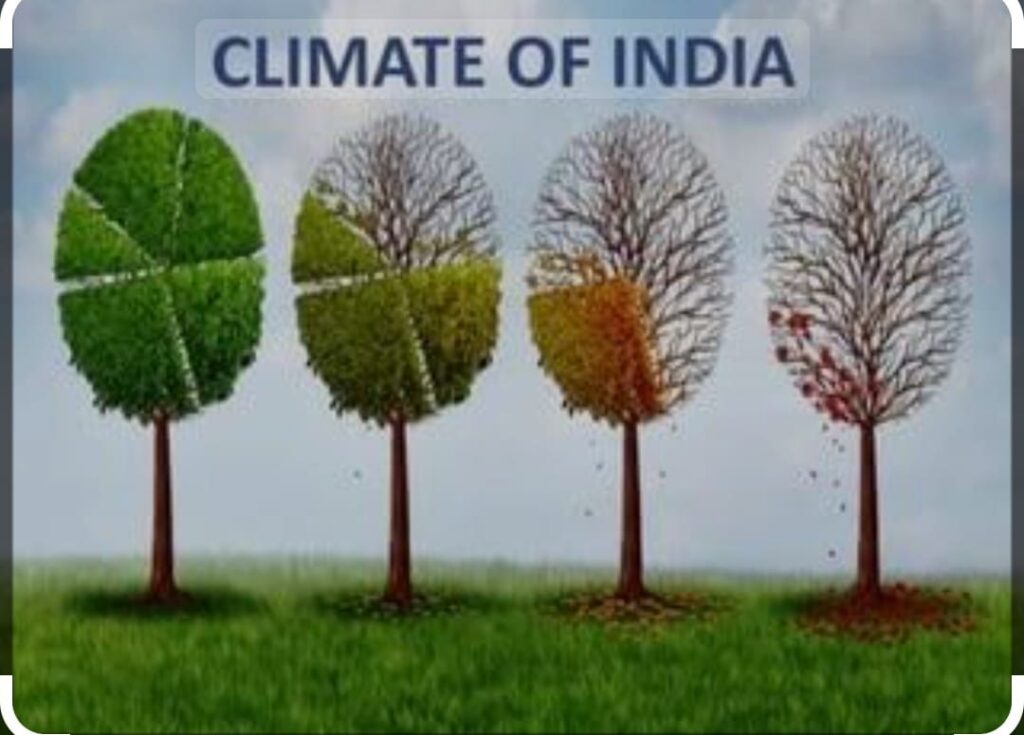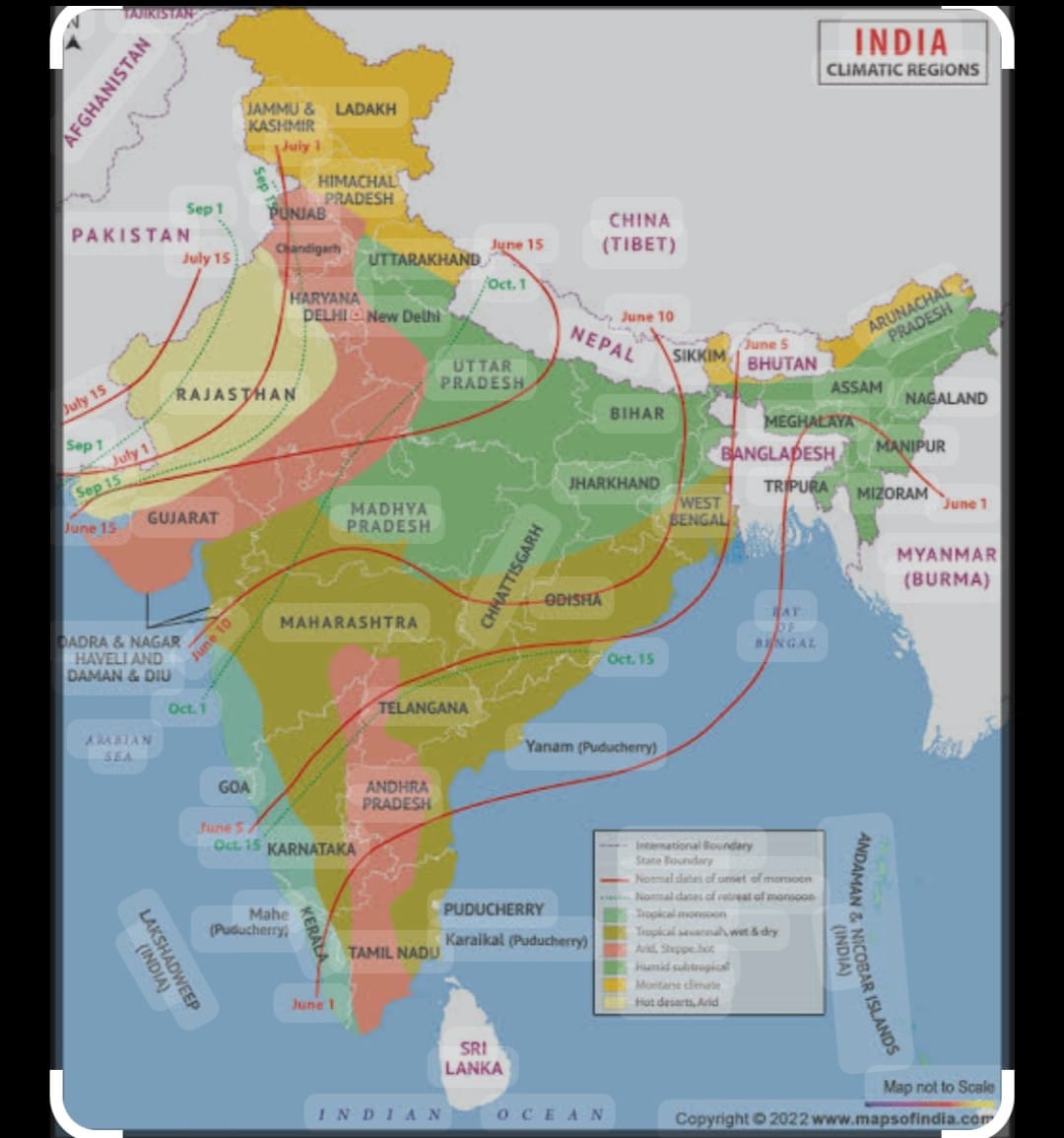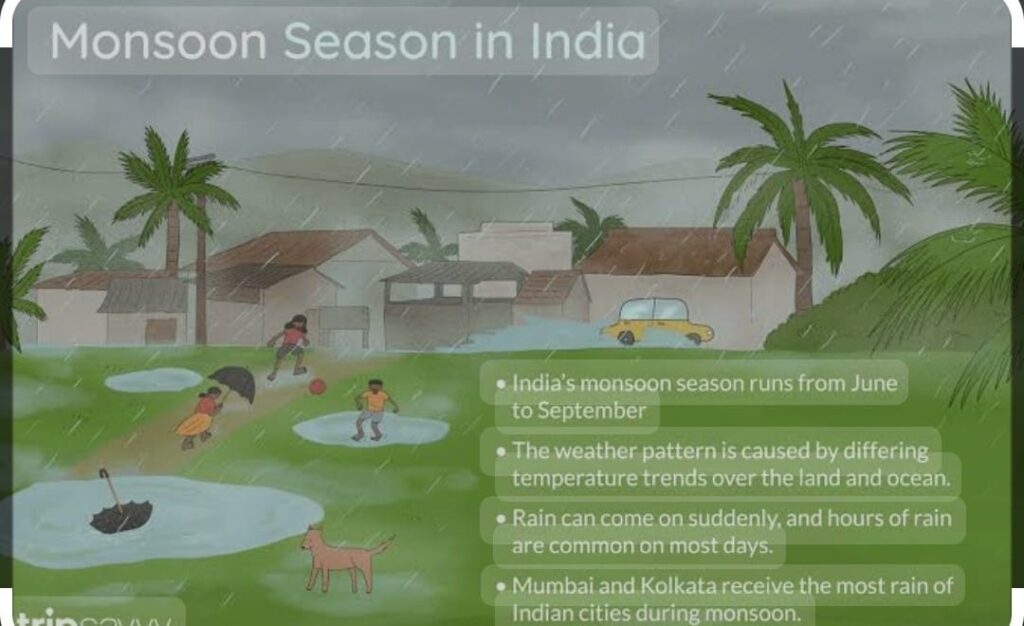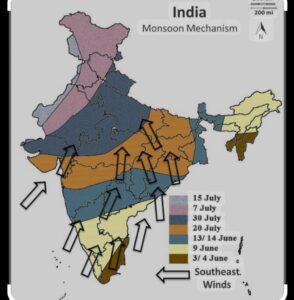Climate in India
Climate in India is the geography chapter that covers the syllabus of class 9th which contain the basic idea of Indian Climatic Condition and effect which covers the whole chapter in detail

The Climate in India comprise of the atmosphere conditions, landforms and the drainage are the three basic elements of any natural environment.
The weather refers to the state of the atmosphere over an aera at any point of time whereas the climate refers to the sum total of weather condition and the variation over a large aera for a long period of time for more tan 30 years.
The elements of weather and climate are same that is temperature, atmosphere pressure ,wind humidity and precipitation.
The weather conditions vary and fluctuate very often even within a day but there is some common pattern over a few weeks / months/ days are cool or hot, windy or calm or bright and wet or dry
On the basis of generalized monthly atmospheric conditions that is divided into seasons such as winter/ summer/ rainy seasons
Tere are some factors that affect the climate in India are
Latitude, altitude ,distance from sea ,ocean current, relief features of land space, pressure and wind system
i) Latitude :
The more we move away from equator colder will be the climate due to curvature of earth the amount of solar energy decreases as we move away from equator to poles
ii) Altitude :
As atmosphere becomes dense and temperature decreases with the increase in height therefore as we move up in height we feel cooler.
iii) Distance from Sea :
The moderating influence of sea by sea breeze decreases with distance therefore the more a place is at distance from the more extreme climatic condition it will have.
iv)Ocean Current :
A cold or warm current accordingly modify the nature of onshore winds and affects the climate therefore the climatic condition of a coastal place is affected by these current.
v)Relief Features :
Due to their size and height they can restrict the flow of Winds and alter the climate of the place therefore the land space like high mountain acts as a barrier for the cold and hot winds they causes the precipitation/ rain / snow
vi)Pressure and Wind system :
The air pressure decreases with increase in height, wind always blows from high pressure to low pressure aera according to Ferrel’s law.
IMPORTANT FACTS about Climate in India:

i) The Tropic of Cancer passes through the middle of the country from Rann of Kuch in Gujarat in west to Mizoram in the east. therefore Climate of India has both tropical as well as sub tropical climates.
ii)The Himalayas prevent the cold winds from central Asia from entering the sub continent .Therefore we experience comparatively milder winter as compared to central Asia
iii) Atmospheric condition associated with climate and weather are pressure and surface winds, upper air circulation , western cyclonic disturbance and tropical
iv) India lies in the north easternly winds ,these winds originate from the subtropical high pressure belt of northern hemisphere
v)Due to the rotation of the earthwards deflects towards the right in the northern hemisphere and towards the left in the southern hemisphere by the force called Coriolis Force this is also called Ferrell’s law
vi) Al Nino is the name given to the periodic development of the warm ocean current along the coast of Peru as a temporary replacement of the cold Peruvian current
. Itis a Spanish word meaning the child and refers to the baby Christ as this starts flowing during Christmas The presence of Al Nino leads to increase in sea surface temperature and weaking of the trade winds in the region
Important facts about monsoons of Climate in India :

i)There is differential heating and cooling of land and water
ii) There is a shift of the position of the inter tropical convergence zone in the summer
iii) The presence of the high pressure aera , in the east of Madagascar due to low temperature. vi) The Tibetan Plateau gets intensely heated during summer
v)The movement of the westerly jet stream to the north of the Himalayas
. vi) The presence of the tropical easterly je stream over the Indian peninsular in summer .
vii) changes in the pressure condition over the southern oceans.
Climate in India is strongly influenced by monsoons winds. monsoon The word is derived from the Arabic word mausim which means season.
It refers to the seasonal reversal in the wind direction during the year. The sailors who came to Indian the historic times were on of the first to have noticed the phenomenon of the monsoon.
The Arabs who had also come to India as traders named these seasonal reversal of the winds system monsoon are experienced in tropical aera roughly between 20 deg N and 20 deg S
Around the time of it’s arrival , the normal rainfall increases suddenly and continues for several days .This is called The Burst Of the Monsoon which is distinguish from the pre monsoon shower of The Climate in India
The monsoon that arrives at the southern tip of the peninsula generally at the first week of June. Subsequently it splits inti two branches the Arabian Sea branch and the Bay of Bengal branch
. i) The Arabian branch reaches Mumbai in about 10 days later on approximately the 10 of June. This is fairly rapid advance . By the mid of June the Arabian Sea Branch of the monsoon arrives over Saurashtra – Kuch and the central part of the country.
ii) The bay of Bengal branch advances rapidly and arrives in Assam in the first week of June. The lofty mountains causes the monsoon winds to deflect towards the west over the ganga plains.
The Arabian sea and the Bay of Bengal branches of the monsoon merges over the north west part of the Ganga plains.

DELHI generally receives the monsoon showers from the Bay of Bengal branch by the end of June 29 (tentative).
By the first week of July western UP , Punjab , Haryana and eastern Rajasthan experience the monsoon. By the mid July Himachal Pradesh receives the rainfall and the rest of the country.
WITHDRAWAL /RETREAT OF RAINFALL / MONSOON in Climate in India is the gradual process that begins in the north western states of India by early September .
By the mid of October it withdraws completely from the northern half of the peninsula and the withdrawal from the southern half of the peninsula is very rapid and by December the monsoon is withdrawn from the entire country.
The islands receive the very first monsoon showers , progressively from south to north, from the last week of April to first week of May.
The withdrawal takes place progressively from the north to the south from the first week of December to first week of January. By this time the rest of the country’s already under the influence of winter monsoon
SEASON OF Climate in India : There are four season found in India the cold weather season , the hot weather season ,the advancing monsoon and the retreating monsoon .
THE COLD WEATHER SEASON / WINTER SEASON : It begins from the mid of November in the northern region and remain till February . The temperature decreases from south to north , Days are warm and nights are cold.

Frost is common in the north and the higher slopes of the Himalayas experience snowfall. the north east trade winds prevails over the country. In the north India , a feeble high pressure region develops, with light winds moving outwards from the aera.
THE HOT WEATHER SEASON / SUMMER SEASON :It begins from March to May. It experience the rise in temperature and falling of air pressure in the northern part of the country .Loo which is strong, gusty, hot , dry winds blowing during the day over the north and northwestern India.

The dust storm are common and sometime may bring light rain and cool breeze. During Summer localized thunderstorm along with the violent wind , torrential downpours accompanied by hail occurs which is called KAAL BAISAKHI in the west of Bengal .
The pre -monsoon showers are common especially in Kerala and Karnataka . They help in the early ripening of mangoes are often called MANGO SHOWERS
ADVANCING MONSOON/ RAINY SEASON : It starts from early of June to September for about 10 days. By the early June low pressure conditions over the north plains is created . It attracts the trade winds of the southern hemisphere.
These trade winds originate over warm sub-tropical aera of the south ocean and enters into India as South west monsoon. These winds blow over the warm ocean and brings abundant moisture to the sub continent and precipitation takes place
The maximum rainfall of the season is received by the north eastern part of the country . Mawsynram( Meghalaya) in the southern ranges of the Kashi hills the highest rainfall in the world .
When the axis of the monsoon through lies over the plains, rainfall is good in the parts on the other hands when ever the axis shifts closer to the Himalayas, there are longer dry spells in the plains and widespread rain occurs in the mountain catchment aeras of the Himalaya rivers.
These heavy rains bring in their wake , devastating floods causing damage to life and property in the plains.
The thickly populated deltas of the Godavari ,the Krishna and the Kaveri are frequently struck by cyclones which causes great damage to life and property.
Parts of the western coast and northeastern India receive over about 400cm of rainfall annually. However it is less than 60 cm in the western Rajasthan and adjoining parts of Gujarat, Haryana and the Punjab .
Rainfall is equally low in the interior of the Deccan plateau and east of the Sahyadri’s mountains are also called the western ghattd,.Owing to the nature of monsoons , the annual rainfall is highly variable from year to year
THE AUTUMN SEASON : During October – November the low pressure over the northern plains due to heat becomes gradually weak and replaced by high pressure system due to cooling effect of rain during monsoon.

The south west monsoon winds weaken and gradually withdraw from northern plain. The retreat marked by clear skies and rise in the temperature with the moist land. Owing to this condition of high temperature and humidity the weather became oppressive during day. this is commonly known as October Heat .
Now low pressure condition transferred to the Bay of Bengal and hence causes Cyclones to eastern coast of India. Monsoon is called the unifying bond of Indian Sub – Continent as India’s fate rests on monsoon.
Conclusion : Climate In India
Climate in India is characterized by its diversity and complexity, largely influenced by the country’s vast size and varied geography.
The primary features of India’s climate include . Monsoon system which dominates the country’s weather patterns, bringing seasonal rainfall crucial for agriculture. From tropical in the south to temperate in the north, India experiences a wide range of climatic conditions. India experiences different seasons, including winter, summer, and monsoon periods. India’s Climate varies significantly across regions, from the arid Thar Desert to the humid Northeast. Impact on life and economy: India’s climate profoundly affects agriculture, water resources, and daily life across the country. To understand India’s climate is essential for addressing challenges like water management, agricultural planning, and adapting to climate change. The country’s unique climatic patterns continue to shape its culture, economy, and development strategies.
Follow us on : Facebook
Follow us on : Instagram
Read More : Drainage
Read More : India size location and Physical Features